The Enlightenment Era also called the Age of Reason, spans from the year 1700 to 1798. Revolutionary in its ways, this period emphasized on rationality, empiricism, and the questioning of traditional authority. It prioritized reason and logic through philosophical and scientific thoughts, sparking broader social, political, and cultural changes in English society.
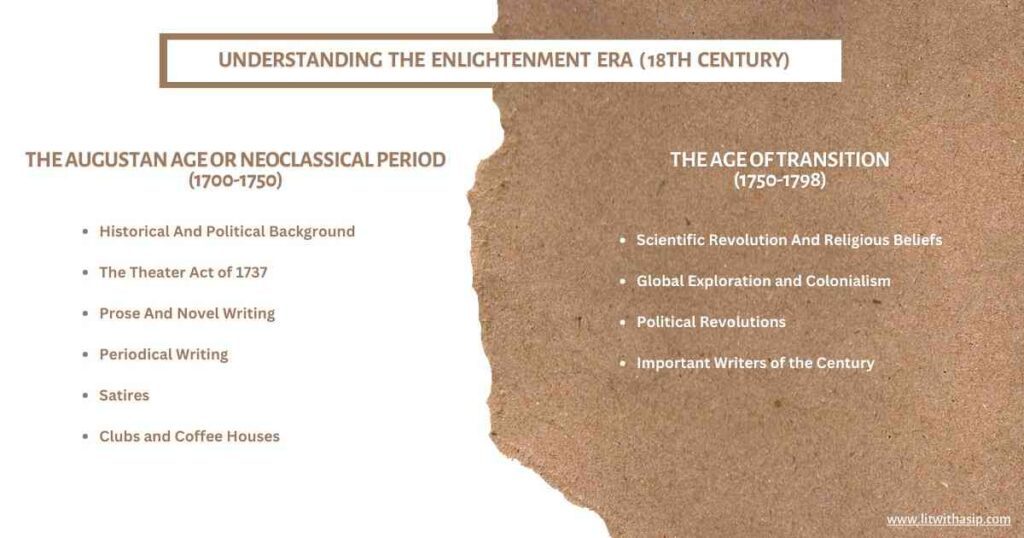
It can broadly be classified into two periods for better understanding, namely the Augustan Age (1700-1750) and the Age of Transition (1750-1798). In this article, we will understand and discuss both of them one by one to have a clearer understanding of this literary century.
The Augustan Age or Neoclassical Period (1700-1750)
The term “Augustan Age” in English literature is named after the Roman Emperor Augustus Caesar. It draws parallels between the cultural and literary achievements of the Augustan Era in Rome (27 BCE – 14 CE) and a later period of literary revival in 18th-century England.
In English literature, this age refers to a period during the 18th century known for its emphasis on classical ideals, reason, and order, mirroring the values espoused during the reign of Augustus Caesar in ancient Rome. English writers of the period, inspired by the Roman classical models, sought to emulate the virtues of clarity, rationality, and restraint in their works. It is because of these developments that the Augustan Age is also termed the Neoclassical period.
Historical And Political Background
To have a clear understanding of the Augustan Age, it is important to learn about the historical background prevalent during the beginning of the 18th century. The Glorious Revolution that began in 1688 with the overthrow of James II led to the ascension of William III and Mary II to the English throne. Mary II lived till 1694 and William III’s reign continued until he died in 1702.
Queen Anne, who ruled from 1702 to 1714, was the last monarch of the House of Stuart. In 1707, the Union with Scotland Act was passed which united the Kingdom of England and the Kingdom of Scotland into a single kingdom called the Kingdom of Great Britain.
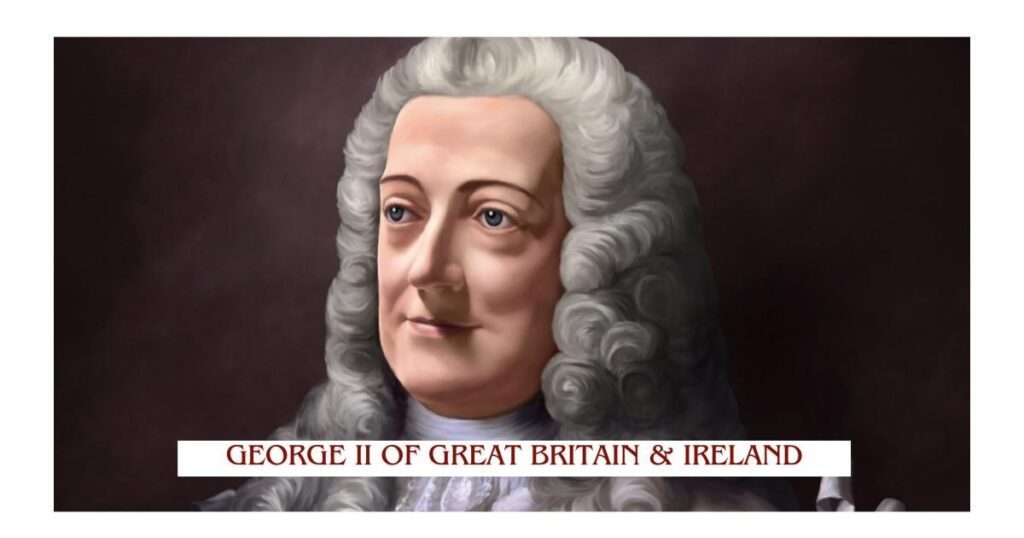
Following this, the Hanoverian monarchy began under George I (1714-1727) and George II (1727-1760). Consolidation of power under the Hanoverian monarchy provided a backdrop of stability and continuity. This political landscape, coupled with the burgeoning Enlightenment ideals of rationality and empiricism, profoundly influenced the literary output of the period.
On the political front, the Neoclassical Period was dominated by two main factions: the Whigs and the Tories. The main differentiation between the Whigs and Tories was their stance on the balance of power between the monarchy and Parliament, with Whigs generally advocating for parliamentary supremacy and Tories supporting the authority of the monarchy. These factions had their roots in earlier political divisions, particularly during the English Civil War and the Glorious Revolution, and they continued to shape political discourse and governance during this period. It should also be noted that the writers during this era also sided with either Whigs or Tories, which is why most of the 18th-century works are politically biased up to a great extent.
The Theater Act of 1737
The Theater Act of 1737, also known as the Licensing Act of 1737, was an act of the British Parliament that imposed censorship on theaters in England. It required that all plays be submitted to the Lord Chamberlain for approval before they could be performed publicly.
This act aimed to regulate and control the content of theatrical productions, particularly to prevent any material deemed troublemaking or immoral. The act gave Lord Chamberlain the authority to censor plays based on their content, leading to a period of strict censorship and government control over the theatrical industry. This led to a shift in literary forms, particularly prose, as a means of circumventing censorship and expressing dissenting or controversial views. Prose provided writers with greater freedom to explore complex ideas, critique society, and engage in political discourse without the constraints imposed by theatrical censorship.
Prose And Novel Writing
Prose, as a literary form, started being associated with the expression of reasoned thought and rational discourse. Unlike poetry, which employed heightened language, meter, and figurative devices, prose adopted a more straightforward and logical way of communicating new thoughts.
Writers like Daniel Defoe, Samuel Richardson, and Henry Fielding capitalized on the growing demand for prose fiction, producing works that reflected the complexities of contemporary society. Contributing to the prose style, essayists such as Joseph Addison, Richard Steele, and Jonathan Swift used prose to engage with a wide range of topics, including morality, politics, religion, and human nature.
Furthermore, the Neoclassical Period witnessed the rise of the novel as a significant literary form, with pioneering works such as Daniel Defoe’s “Robinson Crusoe” and Samuel Richardson’s “Pamela” laying the groundwork for the modern novel. These novels, characterized by their realism, moral lessons, and psychological depth, marked a departure from the fantastical romances of previous eras, reflecting the changing tastes and sensibilities of readers.
Periodical Writing
Periodical writing, which refers to the publication of newspapers, magazines, and journals regularly, has a long history dating back to ancient times. However, the modern concept of periodical writing, characterized by the regular publication of newspapers and magazines for mass circulation, began to take shape during the Enlightenment Era. One of the earliest and most famous examples of periodical writing in the 18th century is ‘The Spectator’, founded by Joseph Addison and Richard Steele in 1711.
The famous prose writers of the 18th century started running their journals which started gaining quick popularity. For instance, ‘The Review’ (1704 to 1713) was written by Daniel Defoe, ‘The Examiner’ (1710) by Jonathan Swift, ‘The Gentleman’s Magazine’ (1731) by Samuel Richardson, and ‘The Rambler’ (1750 to 1752) by Samuel Johnson.
Satires
Satire, a literary genre that utilizes wit to criticize social scenarios, gained prominence in the 18th century. It ridiculed problems of the society, administration, and government with the help of writing by bringing attention to follies, vices, and abuses, somewhere bringing out or calling for improvements. It uses humor as its most essential device.
Some of the most important satires of the century include Jonathan Swift’s ‘Gulliver’s Travels’ (1726), Alexander Pope’s ‘The Rape of the Lock’ (1712), Henry Fielding’s ‘Joseph Andrews’ (1742), Voltaire’s ‘Candide’ (1759), and Samuel Butler’s ‘Hudibras’ (1663-1678). Even to date, Satire remains a popular and relevant form of expression in literature and other media, continuing to challenge authority, expose hypocrisy, and provoke critical thought.
Clubs and Coffee Houses
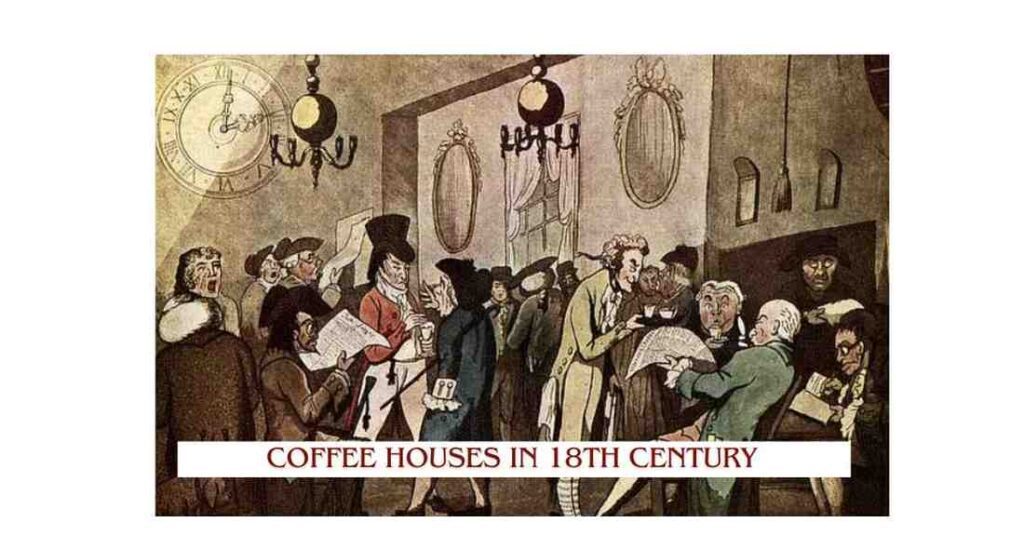
The first half of the 18th century also witnessed a new trend in town, that is, the rising popularity of coffee houses and clubs. These were those little places that became prominent for people to engage in discussion and hot topics, share views, and express thoughts. It became an important way to socialize and included various known personalities of the time, seeking more attraction to the gathering.
For instance, the Kit-Cat Club was a prominent Whig English club that flourished during the reign of Queen Anne (1702-1714) and the early years of King George I (1714-1727). Also, The Scriblerus Club was formed around 1714 in London and was an informal literary club that included several prominent writers of the time.
The Augustan Age or Neoclassical Period, as a whole, represents a period of intellectual, cultural, and literary renaissance in 18th-century England. It was a time when writers and thinkers sought to reconcile the ideals of classical antiquity with the realities of their age, producing works of enduring significance that continue to shape our understanding of literature and society.
The Age Of Transition (1750-1798)
The term “Age of Transition” is often used to describe the period of the 18th century spanning from the year 1750 to 1798. It is named so because this period witnessed transitions on all levels taking from the transition of thoughts, politics, society, and culture to global affairs. This period is also referred to as the “Pre-Romantic Era” because it laid the foundation for the following Romantic Age. In 1755, Samuel Johnson’s “A Dictionary of the English Language” proved to be a monumental work of this age.
As a dynamic and transformative period in European history, the Age of Transition is marked by scientific innovation, philosophical enlightenment, political upheaval, and cultural renaissance. It laid the groundwork for the modern world and shaped the trajectory of Western civilization.
Scientific Revolution And Religious Beliefs
Although science and philosophy became highlights in the Elizabethan Age through Francis Bacon, the Age of Transition saw groundbreaking advancements in astronomy, physics, mathematics, and other scientific fields. The Scientific Revolution included figures like Nicolaus Copernicus, Galileo Galilei, Johannes Kepler, and Isaac Newton who revolutionized the understanding of the natural world, laying the foundation for modern science.
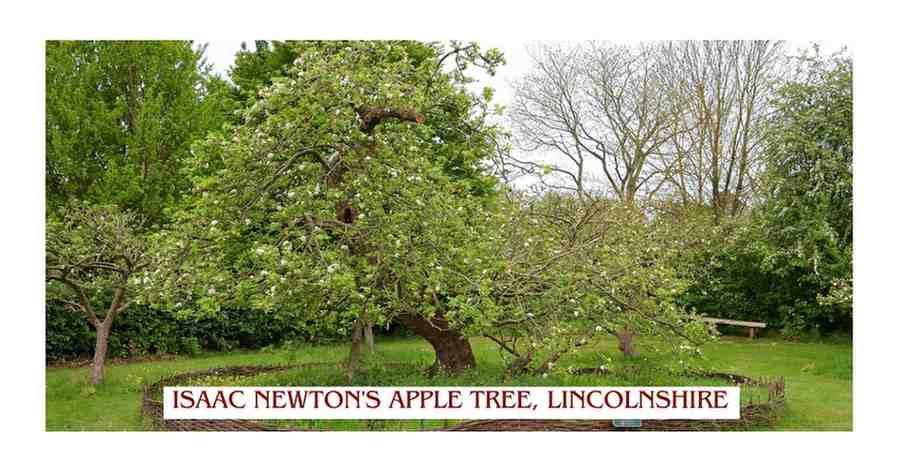
Some of the most important scientific works of the 18th century include:
- Isaac Newton’s formulation of the laws of motion and universal gravitation in his “Philosophiæ Naturalis Principia Mathematica” (1687).
- Carl Linnaeus’s development of binomial nomenclature in his “Systema Naturae” (1735).
- Antoine Lavoisier’s discovery of the role of oxygen in combustion and his development of the modern theory of chemical elements in his “Traité Élémentaire de Chimie” (1789).
- Edward Jenner’s smallpox vaccine development (1796).
These scientific revelations also raised doubts in people concerning their religious beliefs. Copernicus’ heliocentric model, proposed in the 16th century, gained wider acceptance in the 17th and 18th centuries. It challenged the prevailing geocentric view of the universe, where Earth was believed to be the stationary center of creation. This affected Christian communities quite severely.
Copernicus’ model implied that Earth was not uniquely privileged in the cosmos but instead orbited around the Sun like other planets, diminishing the anthropocentric view of the universe and humankind’s special place within it. While some religious authorities initially rejected heliocentrism due to perceived conflicts with biblical passages and theological doctrines, others sought to reconcile scientific discoveries with religious faith, leading to debates.
Global Exploration and Colonialism
The 18th century was characterized by extensive global exploration and colonial expansion, driven by European powers seeking new territories, resources, and trade routes. European nations such as Britain, France, Spain, Portugal, and the Netherlands established vast colonial empires across the Americas, Africa, and Asia, exploiting natural resources, establishing plantations, and engaging in trade.
British exploration continued with the establishment of colonies in North America, the Caribbean, India, Africa, and Australia, with figures like James Cook exploring the Pacific Ocean and mapping parts of Australia and New Zealand.
France established colonies in North America (New France), the Caribbean, India, Africa, and Southeast Asia with explorers like Samuel de Champlain and Louis Antoine de Bougainville mapping parts of North America, the Pacific, and the Indian Ocean.
The Dutch established colonies and trading posts in Asia (Dutch East Indies, present-day Indonesia), Africa (Dutch Cape Colony, present-day South Africa), and the Americas (Dutch Guiana, present-day Suriname). Dutch explorers like Willem Janszoon and Abel Tasman are recognized for mapping parts of Australia and the Pacific.
Portuguese explorers, namely Bartolomeu Dias and Vasco da Gama, mapped routes to India and around the Cape of Good Hope, helping the nation establish colonies and trading posts.
Spain continued to expand its colonial holdings in the Americas, particularly in South America, Central America, and the Caribbean with explorers like Juan Bautista de Anza and Gaspar de Portolà, who explored present-day California.
Additionally, towards the end of the 18th Century, in the year 1798, Great Britain merged with Ireland further expanding the geographical landscape.
Political Revolutions
The Age of Transition also observed several significant political revolutions that reshaped the European political landscape. We have already talked about the Glorious Revolution in England (1688) that impacted the country on the political front. Next in line are several other revolutions that took place almost simultaneously deeply impacting the political and social landscape of the country.
The American Revolution (1775-1783), a pivotal event in world history, witnessed Thirteen American colonies revolt against British rule and establish themselves as an independent nation. Colonialism could be considered a backdrop against which the revolution but it was the will to achieve freedom in Americans that led to the prevalence of this historical event.
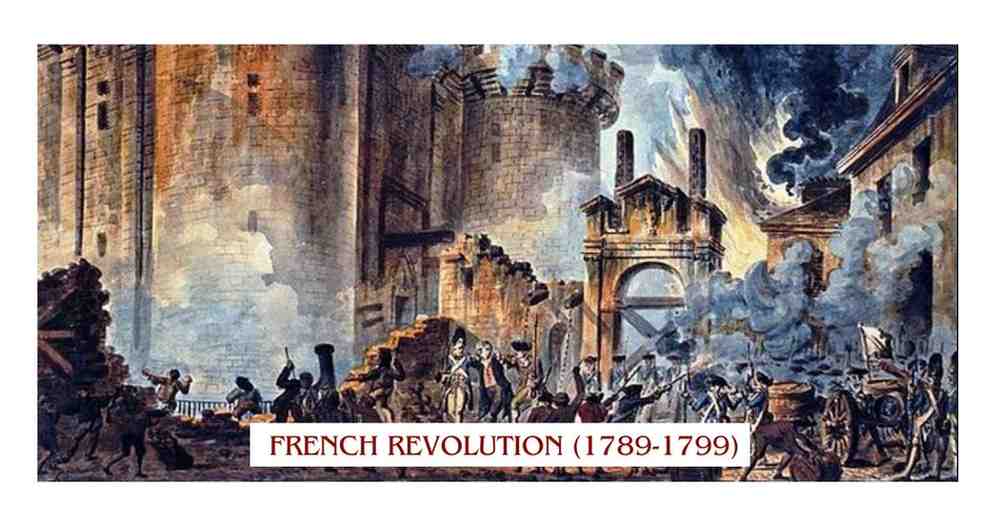
The French Revolution (1789-1799) is another pivotal event in history that is characterized by the overthrow of the absolute monarchy, the establishment of a republic, and the radical restructuring of French society. It was ignited by economic hardships, social inequality, and widespread discontent with the monarchy’s oppressive rule and was a call for freedom and independence among the people.
The Industrial Revolution first began in Britain (1760) but later spread to other parts of the world, taking a toll on nature and humankind. It marked the transition from agrarian and artisanal economies to industrialized economies based on mechanized manufacturing and mass production. It involved the adoption of new technologies such as the steam engine, mechanized textile production, and the use of iron and steel in machinery and infrastructure. It also brought along significant social changes, like the rise of factory-based labor, urbanization, and the emergence of new social classes such as the industrial bourgeoisie and the industrial working class, which were later revolted by various poets, writers, and thinkers. It also gave way to the following Romantic Era of literature.
Important Writers of the Century
- One of the most important writers of the Enlightenment Era included Samuel Johnson, after whose works this period also came to be known as the ‘Age of Johnson’ (1745-1798). His works included literary biographies like “The Lives of the Most Eminent English Poets” and philosophical novels like “Rasselas, Prince of Abyssinia”.
- Daniel Defoe, another renowned writer, is known for his adventure novel “Robinson Crusoe” and gripping narratives like “Moll Flanders”.
- Jonathan Swift is famed for his satirical masterpiece “Gulliver’s Travels” and biting social commentary like “A Modest Proposal”.
- Henry Fielding was acclaimed for his picaresque novel “Tom Jones” and his humorous satire “Joseph Andrews”.
- Alexander Pope is remembered for his satirical verse, including “The Rape of the Lock” and his critical essay “An Essay on Criticism”.
- Laurence Sterne is celebrated for his innovative and experimental novel “The Life and Opinions of Tristram Shandy, Gentleman”.
- Samuel Richardson is known for his groundbreaking epistolary novels “Pamela; or, Virtue Rewarded” and “Clarissa; or, The History of a Young Lady”.
- Transitional poets like Thomas Gray and Oliver Goldsmith also became popular for their way of writing that included notable works such as Gray’s “Elegy Written in a Country Churchyard” and Goldsmith’s “The Deserted Village”, which captured themes of nature, rural life, and human emotion with eloquence and depth.
- William Blake’s contribution, inspiring romanticism, included the visionary poetry collection “Songs of Innocence and Experience”.
Also, coinciding with the Romantic Age and the broader period known as the Age of Transition is Children’s literature, a distinct genre that encompasses a wide range of literary works specifically targeted towards children and young adults. Some of the important writers of this literature included Lewis Carroll, Oscar Wilde, Rudyard Kipling, John Ruskin, F.W. Farrar, and more.
Therefore, with a gradual transition, the Enlightenment Era ended giving rise to Romanticism which valued nature over materialism, individual thought and expression, and inner emotions.

Jennis Jacob, a passionate literary enthusiast in her 20s, is a writer and poet. With eight years of experience in literature, she is currently a master in English and finds inspiration in Womanist, American, and Indian Partition Literatures. Her works have appeared in anthologies such as ‘Carved Words Of Creative Minds’ and ‘100 Splendid Voices,’ and she is working on upcoming books. Through LitWithASip, she aims to ignite a love for literature and empower individuals to embrace their true selves.

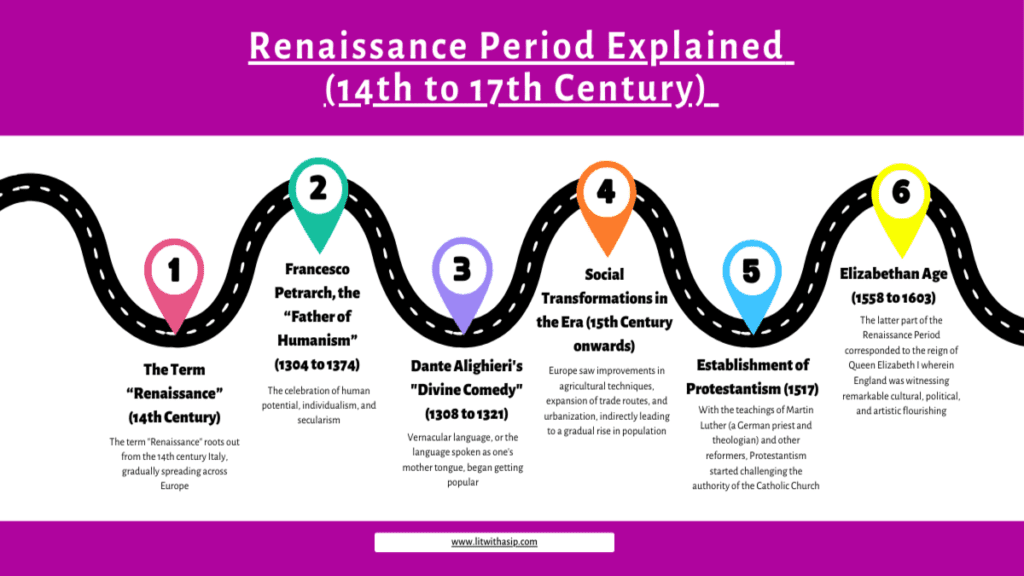
I saw a lot of website but I think this one holds something extra in it in it
I like the valuable information you provide in your articles. I will bookmark your blog and check again here regularly. I am quite sure I’ll learn many new stuff right here! Best of luck for the next!
Excellent post. I was checking continuously this blog and I’m impressed! Extremely helpful info specifically the last part 🙂 I care for such info a lot. I was seeking this certain information for a very long time. Thank you and best of luck.
I got what you mean ,saved to bookmarks, very nice website .
I’m really inspired along with your writing abilities as well as with the format for your weblog. Is this a paid subject or did you customize it your self? Anyway stay up the excellent quality writing, it is rare to peer a great weblog like this one today!
I think this is among the most significant information for me. And i’m glad reading your article. But wanna remark on few general things, The web site style is ideal, the articles is really great : D. Good job, cheers